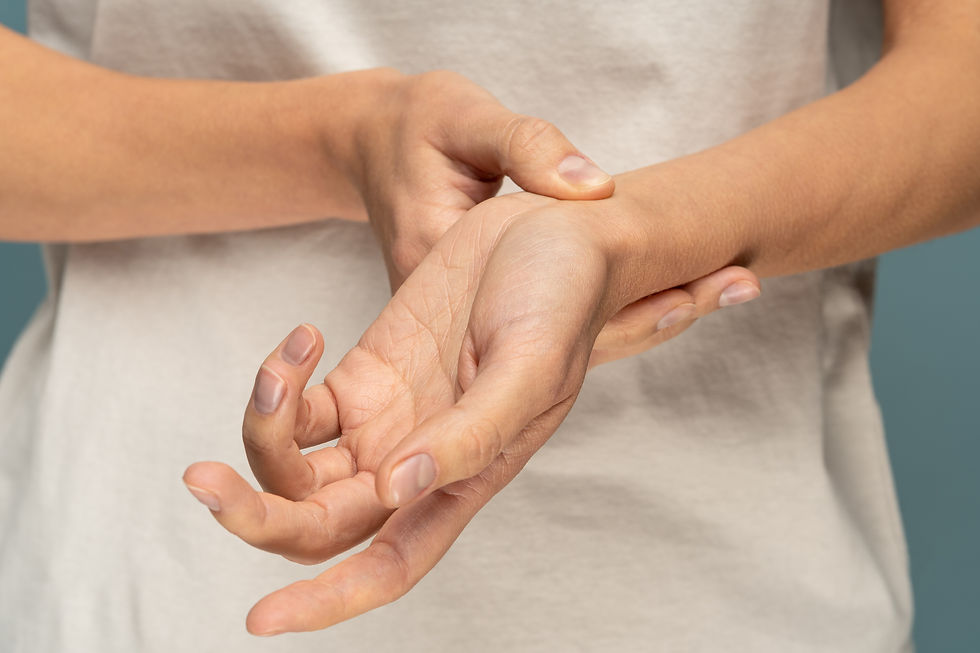Understanding Carpal Tunnel Syndrome and its Relationship with Posture in Pilates Practice
- Michael King

- Feb 27, 2024
- 3 min read

Today, let’s delve into the intricate relationship between Carpal Tunnel Syndrome (CTS) and posture, and how these factors intersect within the realm of Pilates practice.
What is Carpal Tunnel Syndrome?
Carpal Tunnel Syndrome occurs when the median nerve, which runs from the forearm into the palm of the hand, becomes pressed or squeezed at the wrist. This compression can lead to numbness, tingling, weakness, or muscle damage in the hand and fingers.
Causes of CTS:
Repetitive Hand Movements: Continuous, repetitive movements involving the wrist or hand, such as typing, assembly line work, or using vibrating tools, can contribute to CTS.
Hand Positioning: Maintaining awkward or strained hand positions for prolonged periods, especially during activities like typing or using handheld devices, can increase the risk of developing CTS.
Anatomy: Certain anatomical factors, such as a smaller carpal tunnel size or wrist injuries, can predispose individuals to CTS.
Health Conditions: Conditions like arthritis, diabetes, obesity, or hormonal changes, particularly during pregnancy, can also increase the likelihood of developing CTS.
Treatments for CTS:
Rest and Modification of Activities: Initially, resting the affected hand and avoiding activities that worsen symptoms can provide relief. Modifying hand positions and using ergonomic tools can also help reduce strain.
Splinting: Wearing a splint or brace at night can keep the wrist in a neutral position, relieving pressure on the median nerve and alleviating symptoms.
Physical Therapy: Therapeutic exercises aimed at stretching and strengthening the muscles surrounding the wrist can improve flexibility and reduce symptoms.
Medications: Nonsteroidal anti-inflammatory drugs (NSAIDs) or corticosteroid injections may be prescribed to alleviate pain and inflammation.
Surgery: In severe cases where conservative treatments fail to provide relief, surgery to release the compressed median nerve may be recommended.
Impact of Poor Posture on CTS:
Forward Head Posture: When the head juts forward, it can create strain on the muscles and nerves in the neck and shoulders. This strain can radiate down the arms and into the wrists, potentially increasing pressure on the median nerve and worsening CTS symptoms.
Rounded Shoulders: Rounded shoulders often accompany forward head posture and can further contribute to compression of nerves and blood vessels in the neck and shoulders. This compression can impede proper nerve function and exacerbate symptoms of CTS.
Hunched Back: A hunched or rounded back can lead to tightness and stiffness in the muscles of the upper back and shoulders. This muscular imbalance can alter the alignment of the arms and wrists, potentially increasing pressure on the carpal tunnel and exacerbating CTS symptoms.
Slouched Posture: Sitting or standing with a slouched posture can compress the nerves and blood vessels that pass through the shoulder girdle and into the arms. Over time, this compression can contribute to inflammation and irritation of the median nerve, leading to symptoms of CTS.
Addressing Posture in Pilates Sessions:
As Pilates teachers, it's crucial to address poor posture not only for preventing and managing CTS but also for promoting overall musculoskeletal health and well-being. Incorporating exercises that target postural alignment, strengthen the core and stabilizing muscles, and improve flexibility can help alleviate strain on the wrists and reduce the risk of CTS development or progression. Additionally, emphasizing proper body mechanics and alignment cues during Pilates sessions can empower clients to maintain good posture both on and off the mat, supporting their long-term health and vitality.
By understanding the interplay between posture and CTS, Pilates teachers can effectively tailor their instruction to address both aspects, ensuring that clients receive comprehensive support for optimal musculoskeletal health and function.




Comments